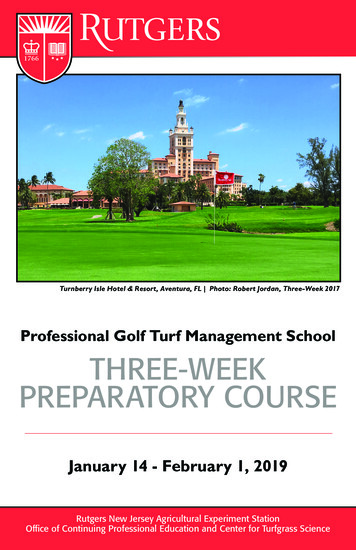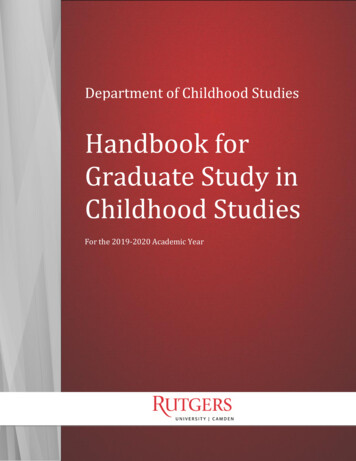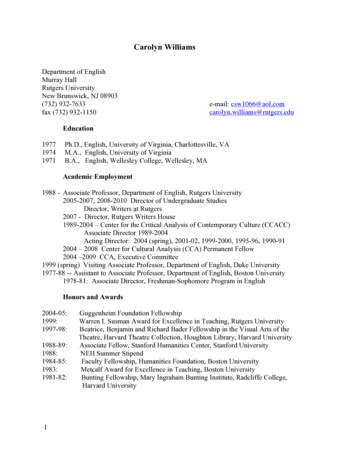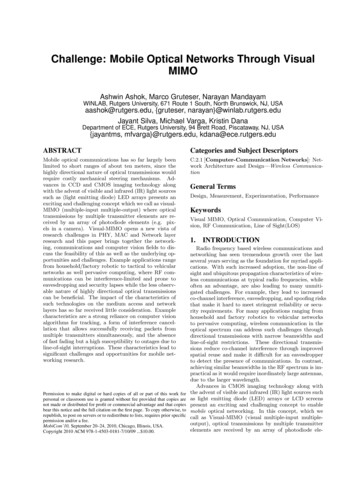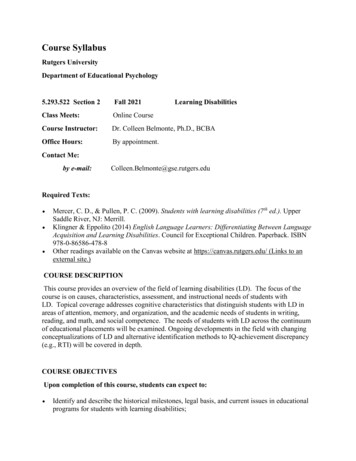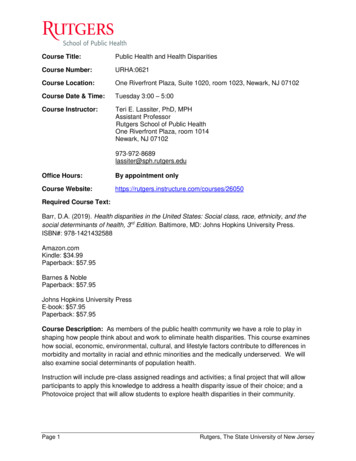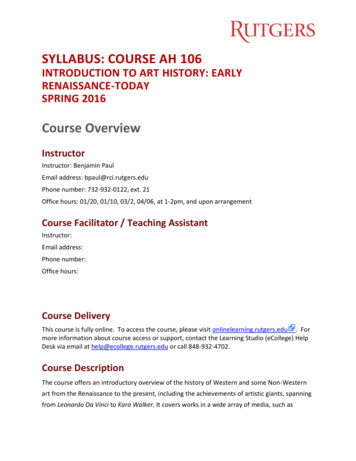
Transcription
SYLLABUS: COURSE AH 106INTRODUCTION TO ART HISTORY: EARLYRENAISSANCE-TODAYSPRING 2016Course OverviewInstructorInstructor: Benjamin PaulEmail address: bpaul@rci.rutgers.eduPhone number: 732-932-0122, ext. 21Office hours: 01/20, 01/10, 03/2, 04/06, at 1-2pm, and upon arrangementCourse Facilitator / Teaching AssistantInstructor:Email address:Phone number:Office hours:Course DeliveryThis course is fully online. To access the course, please visit onlinelearning.rutgers.edu . Formore information about course access or support, contact the Learning Studio (eCollege) HelpDesk via email at help@ecollege.rutgers.edu or call 848-932-4702.Course DescriptionThe course offers an introductory overview of the history of Western and some Non-Westernart from the Renaissance to the present, including the achievements of artistic giants, spanningfrom Leonardo Da Vinci to Kara Walker. It covers works in a wide array of media, such as
2painting, sculpture, architecture, prints, photography, performance, and the moving image.Emphasizing significant stylistic movements primarily in Europe and the Americas but alsoglobally, this class lays the groundwork for more advanced art history courses by introducingvisual analysis and other interpretative tools of art historical research. Students will also learnhow the visual products of a culture relate to historical circumstances, societal values, andshifting personal and collective identities. The skills developed in this course provide importanttools for navigating and interpreting media and visual representation in the twenty-firstcentury.PrerequisitesThere are no prerequisites for this courseImportant DatesThe course begins on 1/20/2016 and ends on 5/13/2016, and the last day to drop the coursewithout a “W” grade is 1/29/2016.Course Learning ObjectivesBy the end of this course, students should successfully be able to: To gain awareness of the major artistic movements from within the last five hundredyears of Western art history To learn the appropriate vocabulary and critical tools for discussing and writing aboutworks of art and architecture. To relate specific works of art and architecture to their stylistic, historical, and socialcontexts.
3Course MaterialsRequired e-TextCengage MindTap for Gardner’s Art through the Ages: A Global History, Enhanced Edition, 15thEdition, 2015. MindTap is a personalized digital space that combines reading, multimediaobjects, and activities to help students analyze, apply, and improve their thinking.Your textbook and digital access to MindTap are only available through your campus bookstore,Barnes and Noble. The ISBN number is 9781337156936.The course is accessed through LearningStudio (eCollege)Technology RequirementsBaseline technical skills necessary for online courses Basic computer and web-browsing skills Navigating Learning Studio (eCollege)Technology skills necessary for this specific course Using MindTapRequired Equipment Computer: current Mac (OS X) or PC (Windows 7 or newer) with high-speed internetconnectionRequired Software Microsoft Word Microsoft Excel Microsoft PowerPointAssessmentAssignment SummaryBelow are the assignments required for this course and the value of each assignment to thecourse grade as a whole. Please refer to the course calendar (on Learning Studio (eCollege))and/or the course schedule (below) for specific due dates.
4See course schedule, below, for due dates.CategoryAssignmentValueParticipation (55%)MindTap Activities13%14 Discussions at 3% Each42%Midterm Exam20%Final Exam25%Assessment (45%)Total100%Assignment OverviewParticipation MindTap Activities can be found in the required e-text for this course, and access isavailable through your LearningStudio (eCollege) course site. In addition to the assignedweekly reading and viewing, activities include practice quizzes and image flash-cards.Students are expected to spend at least 5 hours per week on the MindTap site. This siteis intended as a source of knowledge and learning and, as such, counts toward yourparticipation grade. Scores received in MindTap do not count toward your course grade. Log in to your LearningStudio (eCollege) course site for access to weekly discussionforums. Discussion questions are provided by the professor, and require one initial postplus two additional replies. Look for the discussion rubric in the course site to learnmore about how discussions are evaluated.Assessment Midterm Examo 2 essays, each based on a comparison (a comparison need not necessarily be 1-1,but can include 3 or even 4 slides)o [summarize format, stages, feedback, and other key issues as needed] Final Examo 2 essays, each based on a comparison (a comparison need not necessarily be 1-1,but can include 3 or even 4 slides)
5o [summarize format, stages, feedback, and other key issues as needed]Grading Scale(Source: Rutgers standard undergraduate grade scale)GradeRangeA90 – 100B 85 – 89B80 – 84C 75 – 79C70 – 74D60 – 69FBelow 60Student Participation ExpectationsBecause this is an online course, your attendance is based on your online activity andparticipation. The following is a summary of everyone's expected participation: Logging in:Be sure you are logging in to the course in Learning Studio (eCollege) at least 3 timeseach week, including weeks with holidays. (During most weeks you will probably log inmany times.) If you have a situation that might cause you to miss an entire week ofclass, discuss it with your discussion group leader as soon as possible. Time CommitmentTo be successful in this course, you should plan to dedicate approximately 8-10 hoursper week. Scheduled Meetings:There are two live scheduled events for this course, the mid-term and final exams. Participating in discussion groups:As participation, each week you can expect to post at least three times as part of oursubstantive class discussion on the week's topics.
6Discussion and Communication GuidelinesThe following are my expectations for how we should communicate as a class. Above all, pleaseremember to be respectful and thoughtful. Writing style: While there is no need to participate in your discussion group as if youwere writing a research paper, you should remember to write using good grammar,spelling, and punctuation. Informality (including an occasional emoticon) is fine for nonacademic topics. Please also refrain from using all CAPITAL LETTERS, as this is ofteninterpreted as shouting. Tone and civility: Let's maintain a supportive learning community where everyone feelssafe and where people can disagree amicably. Remember that sarcasm does not alwayscome across online. Treat your discussion group leader and fellow students withrespect at all times, and in all communications. Citing your sources: When we have academic discussions, please cite your sources toback up what you say. (For the textbook or other course materials, list at least the titleand page numbers. For online sources, include a link.) Backing up your work: Consider composing your academic posts in a word processor,where you can save your work, and then copying into the Learning Studio (eCollege)discussion.Support and PoliciesLate Work and Make-up Exams[Fill in late assignment policy]] [WHAT WILL OURS BE? – AZ]Faculty Feedback and Response TimeThe following list will give you an idea of my intended availability throughout the course.(Remember that you can email help@ecollege.rutgers.edu or call 848-932-4702 if you have atechnical problem with LearningStudio (eCollege)). [NOTE SURE ABOUT THIS EITHER- AZ]E-mailYour discussion group leader will reply to e-mails within 24 hours on weekdays. Please includethe course number in the subject line.Threaded Discussion Forums[WILL WE HAVE A DISCUSSION BOARD? – AZ]
7Your discussion group leader will visit the discussion threads regularly, and post to the forumeach week.Academic IntegrityThe consequences of scholastic dishonesty are very serious. Please review the Rutgers’academic integrity policy .Academic integrity means, among other things: Develop and write all of your own assignments.Show in detail where the materials you use in your papers come from. Create citationswhether you are paraphrasing authors or quoting them directly. Be sure always to showsource and page number within the assignment and include a bibliography in the back.Do not fabricate information or citations in your work.Do not facilitate academic dishonesty for another student by allowing your own work tobe submitted by others.If you are in doubt about any issue related to plagiarism or scholastic dishonesty, please discussit with your instructor.Other sources of information to which you can refer include: Rutgers’ Academic Integrity website Code of Student Conduct Eight Cardinal Rules of Academic IntegrityAcademic Support Services Rutgers has a variety of resources for academic support. For more information, checkthe Academic Support website . Rutgers has Learning Centers on each campus where any student can obtain tutoringand other help. For information, check the Learning Center website . Rutgers also has a Writing Center where students can obtain help with writing skills andassignments. Learn more at the Writing Center website . Many library resources are available online. Assistance is available through phone,email, and chat. For information, check the Rutgers Libraries website .Rutgers Health Services Rutgers Health Services is dedicated to health for the whole student body, mind andspirit. It accomplishes this through a staff of qualified clinicians and support staff, and
8delivers services at a number of locations throughout the New Brunswick-Piscatawayarea. For more information, check the Rutgers Health Services website .Accommodations for AccessibilityRequesting accommodationsRutgers University welcomes students with disabilities into all of the University's educationalprograms. In order to receive consideration for reasonable accommodations, a student with adisability must contact the appropriate disability services office at the campus where you areofficially enrolled, participate in an intake interview, and provide documentation. Moreinformation can be found in the Documentation Guidelines section of the Office for DisabilityServices website.If the documentation supports your request for reasonable accommodations, your campus’sdisability services office will provide you with a Letter of Accommodations. Please share thisletter with your instructors and discuss the accommodations with them as early in your coursesas possible. To begin this process, please complete the Registration Form on the Office forDisability Services website.Go to the Student section of the Office of Disability Serviceswebsite for more information.Accessibility and Privacy LinksAccessibility StatementeCollegePrivacy PolicyeCollegeCourse Schedule and Deadlines
9WeekDatesWeekly TopicsIntroduction & Late Medieval and Early RenaissanceNorthern Europe1Jan. 19-24 Video lecture MindTap Readings and Activities Weekly discussion forums(please sign on to the course site for details)Late Medieval Italy & The Renaissance in QuattrocentoItalyFraming videos:2Jan 25-31-Professor Paul, 15 minute videoReading:The Renaissance in Cinquecento ItalyFraming video:-Professor Paul, 15 minute videoReading:Chapter 22: Intro; 22-1 High and Late Renaissance; 22-1aLeonardo ; 22-1b Raphael; 22-1c; 22-1f Venetian Painting,Giorgione, Titian, Women in the Renaissance WorldBonus Image Essay 22-18a Michelangelo's Fall of Man3Assigned Videos:-Columbia Seminar on Raphael's School of Athens (In theYoutube Playlist of MindTap Watch Section)-Michelangelo and the Sistine Ceiling (MindTap Watchsection)Image Flashcards:1, 2,3, 4, 5, 6, 7, 8, 9, 10, 11, 12, 13, 14, 15, 16, 17, 18, 19,20, 21, 22, 23, 24, 25, 26, 42, 43, 44, 45, 46, 47, 48, 49, 504Mannerism in Cinquecento Italy & High Renaissance andMannerism in Northern Europe
10WeekDatesWeekly TopicsFraming video:-Professor Paul, 15 minute videoReading:Chapter 22: 22-2, 22-2a Painting, 22-2b SculptureChapter 23: Introduction; 23-2 Grünewald, Dürer, Lutherand the Reformation); 23-3 The Netherlands; Bosch; PieterBruegelAssigned videos:-Chapter 23: Dürer, The Four Apostles, 1526 (In theYoutube Playlist of MindTap Watch Section)Image Flashcards:-Chapter 22: 51, 52, 53, 54, 55, 56, 57, 58, 59, 60, 61, 62,63, 64, 65-Chapter 23: 1,2,3,4,5,6,7,8,16,23,24,25,26Italian Renaissance ArchitectureFraming video:-Professor Paul, 15 minutesReadings:5-Introduction: Before 1300: Architectural Basics, sections:Byzantine, Gothic, Greece, Roman, Romanesque-Chapter 14: 14-2c Florence Santa Maria del Fiore-Chapter 21: 21-2c Architecture Ospedale degli Innocenti,San Lorenzo, Pazzi Chapel, Palazzo Medici, Leon BattistaAlberti-Chapter 22: 22-1d Architecture: Rome; Bramante, SaintPeter's, Michelangelo, Saint Peter's
11WeekDatesWeekly Topics-Chapter 24: 24-2a: Architecture & Sculpture: SantaSusanna, Maderno and Saint Peter's, Completing SaintPeter'sAssigned videos:-Chapter 22: New Saint Peter's (MindTap Watch section)Image Flashcards:-Chapter 14: 27, 28, 29-Chapter 21: 33, 34, 35, 36, 37, 38, 39, 40, 41, 42, 43, 44,45, 46-Chapter 22: 27, 28, 29, 30, 31, 32-Chapter 24: 2, 3, 4The Baroque in Italy and SpainFraming Video:Professor Paul, 15 minutesReading:6-Chapter 24: Introduction; 24-2a Baldacchino, David,Ecstasy of Saint Teresa; 24-2b Painting, Annibale Carracci,Loves of the Gods, Caravaggio, Musicians, Calling of SaintMatthew; 24-3 Spain and New Spain: Francisco deZurbaran, Diego Valazquez, Patron's Voice, Las Meninas-Bonus Image Essay 24-18A Caravaggio, Saint PaulAssigned Videos:-David, David and David (MindTap Watch section)Image Flashcards:6, 7, 8, 9, 10, 11, 21, 22, 23, 24, 25, 26, 35, 37, 38, 39, 40,417The Baroque in Northern Europe
12WeekDatesWeekly TopicsFraming Video:Professor Paul, 15 minutesReading:Chapter 25: Introduction; 25-2 Flanders; 25-2a Painting,Rubens, Consequences of War, Arrival of Marie de'Medici; 25-3 Dutch Republic; 25-3a Art and Society; 25-3cRembrandt; 25-3e Vermeer; 25-4 France; 25-4a Louis XIVAssigned Videos:-Rembrandt's Night Watchhttps://www.youtube.com/watch?v 0D rc92g27wImage Flashcards:1, 2, 3, 4, 5, 6, 14, 15, 16, 17, 18, 19, 20, 24, 25, 26, 31, 32,33, 34, 35, 36, 37, 38Midterm Exam & The RococoFraming videos:Professor Zervigon, 5 minute Video OverviewProfessor Zervigon, 15 minute Video Lecture basedon Powerpoint slides of his own: The RibaldRococoReading:-[DATES,8 DEADLINES?– AZ]Chapter 26 Introduction, sections 26-1, 26-2, 26-3,26-4Bonus Essay:-Antoine Watteau, L’Indifférent (MindTap ReadSection)Assigned Video:-Antoine Watteau, Pilgrimage to Cythera (In theYoutube Playlist of MindTap Watch Section)Image Flashcards:-Image Flashcards for Chapter 26 (images 3, 11-16).Can you say at least 2 things about each work?
13WeekDatesWeekly TopicsNeoclassicism, Romanticism, Realism, PhotographyFraming video:-Professor Zervigon, 20 minutesReading:-Chapter 26, sections 26-5 and 26-6; Chapter 27Bonus Essays:-Élisabeth-Louise Vigée-Lebrun, Marie Antoinetteand Her Children (MindTap Read Section)-Anne-Louis Girodet-Trioson, Jean-Baptiste Belley(MindTap Read Section)-Honoré Daumier, Nadar Raising Photography tothe Height of Art (MindTap Read Section)Assigned videos:-Interview by Prof. Weigert of Prof. Zervigon onearly photography (30 minutes)- Jacques-Louis David, The Death of Marat(https://www.youtube.com/watch?v Hw2 hv439Fg)9-Delacroix, Liberty Leading the People (In theYoutube Playlist of MindTap Watch Section)Caspar David Friedrich, Abbey among Oak Trees (Inthe Youtube Playlist of MindTap Watch Section)- Manet, Olympia(https://www.youtube.com/watch?v bihBbqzL96Y)Image Flashcards:--Chapter 26 (images 23-45)-Chapter 27 (all 70 images)Can you say at least 1 thing about each work basedon the readings?Quizes (practice only):-Chapter 26 (20 questions)Chapter 27 Quiz (20 questions)
14WeekDatesWeekly Topics10SPRING BREAK!Impressionism, Post-Impressionism, Fauvism, Edo JapanFraming video:-Professor Zervigon, 20 minutesReading:-Chapter 28 and Chapter 34 (chapter introductionand section 34-3)Bonus Essays:-Berthe Morisot, In a Villa at the Seaside (MindTapRead Section)-Louis Henry Sullivan, Wainwright Building(MindTap Read Section)Assigned videos:-Matthew Collings: Impressionism, Revenge of theNice 1/10 (In the Youtube Playlist of MindTapWatch Section)-Matthew Collings: Impressionism, Revenge of theNice 6/10 (In the Youtube Playlist of MindTapWatch Section)11-Woodblock Prints and Japonisme (MindTap Watchsection)Image Flashcards:-Chapter 28 (all 59 images)Chapter 34 (images 1, 15-17)Can you say at least 2 things about each workbased on the reading?Quiz, practice only:-Chapter 28 (20 questions)Modernism in Europe and America12Framing video:-Professor Zervigon, 20 minute framing video and
15WeekDatesWeekly Topicsinformal lecture on Cubism and African art,offering alternative view from textbookReading:-Gardner, Chapter 29 and Chapter 37 (ChapterIntroduction and sections 37-1 & 37-2)Bonus Essays:- Large ceremonial spoon or ladle, Dan, fromwestern Côte d’Ivoire or Liberia (MindTap ReadSection)-Paula Modersohn-Becker, Self-Portrait with AmberNecklace (MindTap Read Section)-Marcel Duchamp, L.H.O.O.Q. (MindTap ReadSection)Edward Weston, Nude (MindTap Read Section)Assigned Videos:-From Artists' Aid to Art Itself: A Brief History ofPhotography (MindTap Watch Section)Bauhaus: A History and its Legacy (click to Youtubelink:https://www.youtube.com/watch?v xYrzrqB0B8IImage Flashcards:- Chapter 29 (all 100 images). Can you follow theinfluence from one work of art to another? Wheredo you see the influence of African masks andsculpture, and how was this a missreading of theseobjects?Quiz (practice only)-Chapter 29 Quiz (20 questions)Modernism and Postmodernism in Europe and America13Framing Video:-Professor Zervigon, 20 minutesReading:
16WeekDatesWeekly Topics-Chapter 30Bonus Essays:-Gerhard Richter, Townscape Paris (MindTap ReadSection)-Eva Hesse, Hang-Up (MindTap Read Section)Assigned Videos:-Hans Namuth - Pollock Painting (In the YoutubePlaylist of MindTap Watch Section)-I Love Warhol: Andy Warhol Interviewed on PopArt in 1964 (click to Youtube link:https://www.youtube.com/watch?v jr8NE7r1szU- Lygia Clark and her "Abandonment" in MoMAhttps://www.youtube.com/watch?v HZ4TXDlUwQc- Bicho by Lygia Clarkhttps://www.youtube.com/watch?v 7Cq2OVD7dvAImage Flashcards:-Chapter 30 (all 72 images). Can you place each ofthese works on a line of development afterPollock?Quiz (practice only)-Chapter 30 (20 questions)Contemporary Art WorldwideFraming Video:-Professor Zervigon, 20 minutesReading:14-Chapter 31Bonus Essays:-Guerrilla Girls, The Advantages of Being a WomanArtist (MindTap Read Section)-Robert Arneson, California Artist (MindTap Read
17WeekDatesWeekly TopicsSection)Assigned Videos:-Identity Politics and Art (In the MindTap WatchSection)Inside the Chinese Contemporary Art Scene (In theYoutube Playlist of MindTap Watch Section)-El Anatsui: Studio Process. Click to Youtube link:https://www.youtube.com/watch?v d3RIE195JIImage Flashcards:-Chapter 31 (all 68 images)- Consider for each: What different media areemployed and what is the role of representation?Quiz (practice only):- Chapter 31Course Review and Final Exam Review15[WHAT SORT OF ASSIGNMENTS OR ACITIVIES HERE,BEYOND DISCUSSION ROOM WORK? – AZ]
This course is fully online. To access the course, please visit onlinelearning.rutgers.edu . For more information about course access or support, contact the Learning Studio (eCollege) Help Desk via email at help@ecollege.rutgers.edu or call 848-932-4702. Course Description


